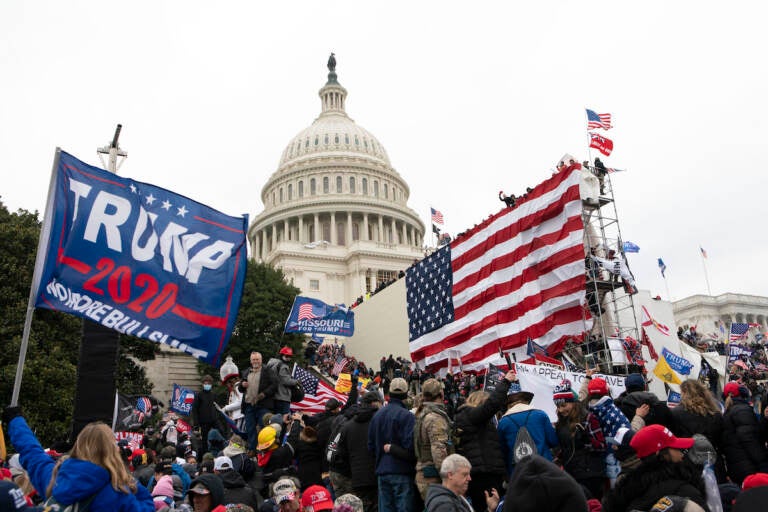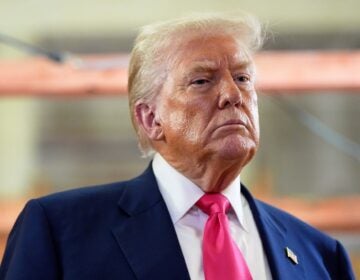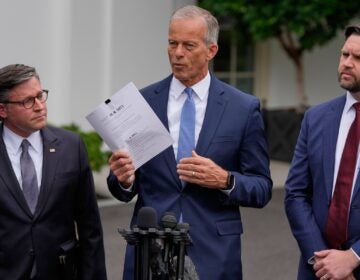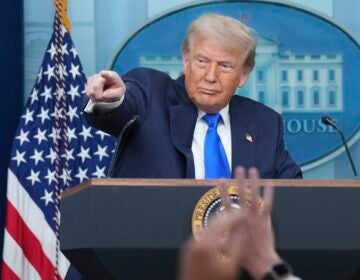The meeting that changed history and 3 other takeaways from the latest Jan. 6 hearing

Pro-Trump insurrectionists stand outside the U.S. Capitol in Washington on Jan. 6, 2021. (AP Photo/Jose Luis Magana, File)
Former President Trump knew there was no evidence of widespread election fraud because people close to him told him so on multiple occasions. Many of those same close advisers repeatedly told Trump to concede after the Electoral College voted in mid-December to confirm President Biden’s 2020 victory.
But Trump instead made a fateful choice in the early morning hours of Dec. 19, days after the electors voted, to choose a path that led to the insurrection on Jan. 6.
That’s according to witness testimony and evidence presented at the seventh Jan. 6 committee hearing Tuesday.
“President Trump is a 76-year-old man; he is not an impressionable child,” said committee Vice Chair Rep. Liz Cheney, R-Wyo., responding to those defending the former president and saying that Trump was simply influenced by the wrong people. “Just like everyone else in our country, he is responsible for his own actions and his own choices.”
She added that perhaps more than anyone else in the country, Trump had access to “detailed and specific information” showing that claims of widespread fraud in the election were not true, but he chose not to believe it.
“No rational or sane man in his position could disregard that information and reach the opposite conclusion,” Cheney said.
Cheney, who warned of potential witness tampering at the end of the last hearing, also dropped toward the end of this one that Trump had tried to call one of the witnesses who hasn’t testified yet. She said it had been referred to the Justice Department.
There were lots of eye-openers like that, but here are four takeaways from the hearing:
1. An explosive meeting on Dec. 18 was the turning point that set the Jan. 6 insurrection in motion
The committee spent much of the hearing detailing the “tense” late-night Oval Office meeting with Rudy Giuliani, conspiracy theorist lawyer Sidney Powell, ex-Gen. Michael Flynn, who has ties to the QAnon movement and extremist groups, as well as former Overstock.com CEO Patrick Byrne on one side and White House lawyers Pat Cipollone, Eric Herschmann and staff secretary Derek Lyons on the other.
It was essentially the White House professionals, or a version of “Team Normal,” as former Trump campaign manager Bill Stepien coined it in an earlier hearing, against, let’s call them, Team Conspiracy.
Team Conspiracy was let into the White House complex by a junior staffer without the knowledge of the White House lawyers. The lawyers were determined to stop what the other team was proposing to the president, including the immediate mass seizure of voting machines by the U.S. military.
There was screaming, threats of violence and insults, including Herschmann telling Team Conspiracy that what it was proposing was “nuts.” Giuliani testified that at one point he told Team Normal, “I’m going to categorize it as you guys are not tough enough. … You’re a bunch of p******.”
The committee showed in multiple ways that this group didn’t have the evidence – and knew it didn’t. Cipollone said he repeatedly told them to present their evidence, and they wouldn’t because they didn’t have any.
The meeting went until after midnight with Trump at the center. At one point, Powell said Trump told her “You see what I deal with? I deal with this all the time.”
Trump then made the decision that changed the course of history. He sided with Team Conspiracy and tweeted, in part, at 1:42 a.m. ET:
“Statistically impossible to have lost the 2020 election. Big protest in D.C. on January 6th. Be there, will be wild!”
2. That tweet essentially inspired right-wing extremists to mobilize — and become Trump’s insurrection army
Trump’s tweet that day had a clear impact on the coalescing around the importance of going to Washington on Jan. 6.
This was shown through testimony of the two in-person witnesses Tuesday – Jason Van Tatenhove, a former spokesman for the Oath Keepers, a violent militia group, and Stephen Ayres, a former Trump supporter from Ohio who pleaded guilty to illegally entering the Capitol on Jan. 6.
Both men testified that they, and people like them, were inspired to go to Washington on Jan. 6 because of that tweet.
A former Twitter employee, whose identity was obscured, testified that it was as if a mob was being gathered. Prior to Dec. 19, he said, it was vague and non-specific, but it was very clear that individuals were ready, willing and able to take up arms. After Dec. 19, the man said, not only were they willing and able, but the leader of their cause was asking them to join him in fighting for their cause on Jan 6.
Founders of dark websites, like Jim Watkins, founder of 8kun, said he bought a ticket to D.C. after Trump’s tweet.
The founder of TheDonald.win said that after Trump’s tweet, “anything else was shut out,” and it was all about Jan. 6.
Trump knew the power of his tweets, and from past hearings, it was clear he knew his supporters could get violent on Jan. 6. Cassidy Hutchinson, the aide to former Trump Chief of Staff Mark Meadows, testified that Trump was warned by former Director of National Intelligence John Ratcliffe and others of that possibility.
3. Connections to Trump are growing closer, but direct evidence of Trump’s coordination with extremists was harder to come by
Given Trump knew the power of his tweets, that he was warned that his supporters could get violent and knew that they had weapons on Jan. 6 at his speech, and that his encouraging a march to the Capitol was preplanned and not spontaneous, it stands to reason that Trump certainly knew what could happen.
Given his lack of a desire to discourage the violence and how long it took him to finally tell people to leave the Capitol once the violence began, given he never called the military, his attorney general or the Department of Homeland Security to help quell it, and given even after it all happened, he has sympathized with the rioters, one could reasonably conclude that Trump wanted what happened Jan. 6 to happen.
But that’s different from proving it with hard, prosecutable evidence.
Let’s go through what the committee presented Tuesday that builds a trail of crumbs closer to Trump:
- The committee showed that extremists seemed to have some prior knowledge of what was going to happen on Jan. 6, notably that Trump was going to order people to march to the Capitol.
- There was a text exchange between Mike Lindell, the CEO of a company that makes pillows, and Kylie Kremer, one of the crowd organizers that day with the Stop the Steal movement. She’s the daughter of Amy Kremer, the Tea Party Express founder who moved into pro-MAGA organizing. In one exchange Kylie Kremer tells Lindell of a potential march to the Capitol on Jan. 6 that “POTUS is going to just call for it unexpectedly.”
- Ali Alexander, a far-right activist who was also involved with Stop the Steal, also seemed to know this information ahead of time. In one text message shown by the committee, Alexander writes, “Ellipse then US capitol. Trump is supposed to order us to capitol [sic] at the end of his speech but we will see.”
What we didn’t get, however, is how they knew that. Rep. Stephanie Murphy, a member of the committee who helped lead Tuesday’s hearing, said on MSNBC after the hearing that former Trump aide Katrina Pierson told Kremer, but she doesn’t know how Alexander knew.
Did Alexander get it from Kremer? Did he get it from former Trump adviser Roger Stone, who was also involved with Stop the Steal and who also spoke with Trump before Jan. 6? From Trump himself? Those dots weren’t connected.
The committee also revealed:
- Steve Bannon, the CEO of Trump’s 2016 campaign, spoke with Trump twice on Jan. 5 and then went on his podcast seemingly with inside knowledge of what would happen the next day.
Did the president tell him something? Or was a provocateur being provocative? We don’t know.
- White House aide Sarah Matthews said in a Jan. 5 meeting Trump said to staff: “How can we make the RINOs do the right thing tomorrow?” A witness also testified that Trump’s mood was seemingly uplifted and that he got practically giddy when he saw and heard the crowd gathering in D.C. ahead of his Jan. 6 speech. Was that because he knew what was going to happen or because he loves crowds of supporters?
This was the first hearing that didn’t quite live up to its own lofty expectations. The committee said it would draw the connection between Trump, his allies and the right-wing extremist groups. The dots may have been put on the table, but they weren’t boldly connected.
After the hearing, Raskin acknowledged on CNN there’s a difference between “causation” in a legal context and what the committee is doing.
“We’re not prosecutors,” he said. But, he added, “In the moral and political context, the language that a leader uses is important in a democracy.”
The Justice Department has an active investigation into Jan. 6 and has been following the committee hearings’ revelations closely. But regardless of whether Trump is convicted of a crime, Van Tatenhove sees an arguably bigger threat.
“I do fear for this next election cycle,” he said, “because who knows what that might bring — if a president that’s willing to try to instill and encourage to whip up a civil war among his followers, using lies and deceit and snake oil and regardless of the human impact, what else is he going to do if he gets elected again?”
The committee has one more hearing planned, next week, July 21, in prime time. It says it will focus on Trump’s inaction to stop the attack on the Capitol and will detail a 187-minute timeline when Trump was silent inside the White House as the riot unfolded.
9(MDAzMzI1ODY3MDEyMzkzOTE3NjIxNDg3MQ001))




